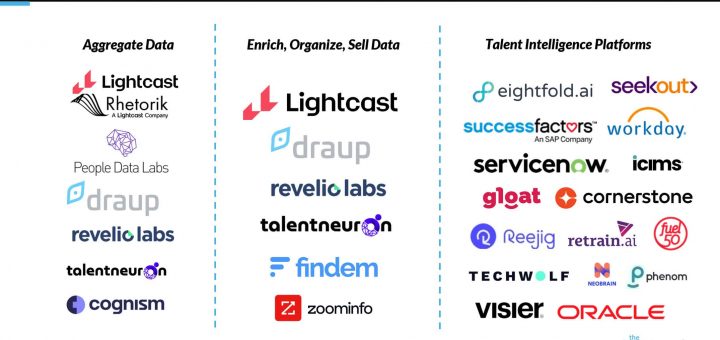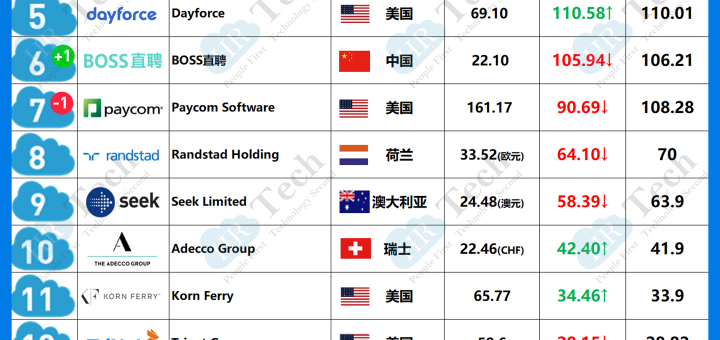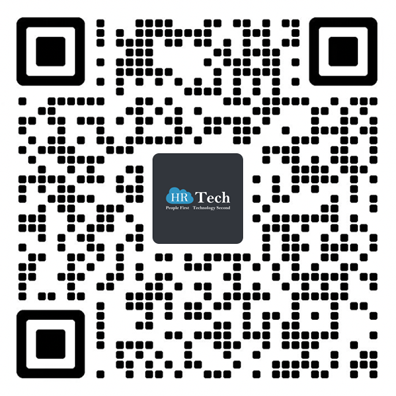-
 people data
Josh Bersin专栏:“人才情报市场”爆发,AI 如何重塑招聘、技能与决策? HRTech概述:在当今数据驱动的时代,“人才数据” “People Data ”已成为企业最重要的资产之一。Josh Bersin 在其最新分析中指出,人才情报市场正在快速发展,形成从数据收集(如 Rhetorik)、数据建模(如 Lightcast、Revelio)、到智能平台(如 Galileo、Seekout)的三层架构。Lightcast 收购 Rhetorik 不仅加强了全球人才画像能力,还拓展至销售与营销数据领域。借助 AI,企业HR如今能通过对话式系统实现招聘推荐、技能评估、内部流动等多项功能。这场由数据与AI驱动的革命,正在重塑HR的专业边界。 原文题目:People Data For Sale: How The Talent Intelligence Market Works 作者:Josh Bersin · 2025年7月16日 在我们经济中,**“人力数据市场”**是最具活力和影响力的部分之一。每位招聘人员、选址专家、人力资源高管、经济学家、大学校长和政府规划者都希望知道:哪些岗位在增长?哪些技能最受欢迎?薪资趋势如何变化?还有更多相关洞察。 虽然很多人了解美国劳工统计局(BLS)发布的公共调查数据,但在其背后,有一个更加先进、由 AI 驱动的产业:“人才数据市场”。 人才数据市场的结构 几十年来,像 Monster.com、LinkedIn 等公司,以及其他数百家公司,通过算法抓取了关于个人、职位和企业的信息。最初,他们这么做是为了开发产品和服务。但如今,**“数据采集本身”**已成为一项庞大的商业活动。 大致来说,该市场可以分为三类供应商,且部分公司跨界经营。 第一类:数据聚合商(Data Aggregators) 代表企业包括:Rhetorik(已被 Lightcast 收购)、Lightcast(职位市场数据)、People Data Labs(PDL)、SignalHire、Revelio Labs、Cognism、Coresignal、Draup、Talent Neuron 等。 这些公司专注于大规模采集专业个人档案数据,信息来源包括公共记录、网页抓取(例如 LinkedIn 的公开资料)以及与一些小型数据供应商的合作,有些合作甚至涉及隐秘运作(如以色列的情报公司)。 部分聚合商如 Revelio、Draup、TalentNeuron、Lightcast 等,也会直接销售产品,因此在某种程度上也属于第二类供应商——数据整理与建模者。 第二类:数据整理与建模商(Data Enrichment & Organizers) 这类公司会将数据进行分类、构建技能模型、统一职位名称等,将海量非结构化数据组织成可用信息。他们的价值在于推理、日常更新以及与通用框架的整合。 代表公司包括:Lightcast(领先者)、Draup、Revelio Labs、TalentNeuron、Findem、ZoomInfo 等。后者多聚焦于销售与金融领域。 他们的技术团队会处理每天新增的数百万条记录,将其整理成职业分类体系(例如职位模型、职业编码),并推演出一个人的技能、雇主、教育背景、薪资与地理位置等信息之间的关联。 随后,这些数据会以 API 接口、数据连接器等形式供第三方平台调用。 这类数据处理非常复杂。例如,一个人的数据链会包含教育、技能、工作经历、雇主、所在城市等;这些又会连接到公司层级的信息,包括企业历史、产品、投资和技术项目等。 当这些公司把数据组织得足够好时,可以回答如下问题: 哪些职位越来越值钱? AI 工程师的技能是如何细分的? 电动车工程师需要哪些新兴技能? 哪些能源科技正在崛起?哪些公司在使用?我要如何找到这些人才? 这些能力,将使得使用这些平台的企业在人才市场上领先对手数倍。例如,很多公司用 Lightcast 进行选址决策,投资金额甚至高达数亿美元。 第三类:人才智能平台(Talent Intelligence Products) 这是产业链的第三环节。 这类公司(包括几乎所有 HR SaaS 厂商)将上述数据集成进企业的招聘系统、技能分析、规划、内部流动等流程中。它们的任务是将外部人才数据与企业内部数据融合,从而使 HR 系统变得“智能”。 举个例子:你想为某项目寻找最适合的市场或工程人才,但公司 HR 系统只记录了职称和学历。借助上述数据平台,这些系统可以告诉你:谁才是真正合适的人选?甚至还能预测谁具备晋升潜力。 人才数据市场的高价值应用场景 该市场主要面向四大类终端用户: 企业客户:用于人力规划、招聘分析、技能战略。 教育机构:用于课程设计、学生就业评估、经济影响评估。 政府单位:用于经济发展、政策制定和劳动力投资。 销售与市场团队:用于线索生成、市场细分和客户画像构建。 对企业来说,这类数据对增长与绩效至关重要。随着 AI 系统普及,对高质量人才数据的需求也越来越高。 例如,Galileo 是一款直接接入 Lightcast 数据的 AI 工具。你可以上传10位员工的姓名、职位、简历和会议记录,让 Galileo 进行能力评估、对比与基准分析。这一功能可用于绩效管理、发展辅导、岗位设计与招聘决策。 Josh 本人还尝试过让 Galileo 分析过去 6 个月的公司会议数据,它能自动识别出员工姓名、技能强项与弱项,有些甚至是他自己之前未曾意识到的。 更重要的是,这只是冰山一角。通过这些数据+AI,企业可以: 智能筛选候选人 分析薪酬与外部趋势对比 进行绩效分析与技能对标 而这一切,都可以通过像 Seekout、Galileo、Eightfold 等 AI 系统实现,进入“对话式分析”新时代。 最新动态:Lightcast 为何收购 Rhetorik? 作为行业巨头,Lightcast 最近收购了数据采集公司 Rhetorik。这不仅增强了其人才画像数据源,还标志着其正式进军营销与销售数据市场。 目前 Lightcast 已覆盖三大市场:企业、教育与政府。此次收购将: 丰富 Lightcast 的员工数据维度 拓展销售/市场线索类数据应用 强化其在技能建模、薪酬基准、职业路径等方面的领先地位 借助现有数据科学团队,Lightcast 有望在多个市场领域实现倍增式增长。 AI 正在加速这个市场的演进 Josh 在播客中指出,AI 工具如 Galileo、Microsoft Copilot 等,让每位 HR 或管理者都能轻松使用这些复杂的数据系统。 你不再需要编写报告或查询数据库,只需提问,系统即可给出有洞察力的答案。 Lightcast 也正是意识到 AI 驱动的市场机会,才会加快产品布局,以巩固其市场领先地位。people data2025年07月16日
people data
Josh Bersin专栏:“人才情报市场”爆发,AI 如何重塑招聘、技能与决策? HRTech概述:在当今数据驱动的时代,“人才数据” “People Data ”已成为企业最重要的资产之一。Josh Bersin 在其最新分析中指出,人才情报市场正在快速发展,形成从数据收集(如 Rhetorik)、数据建模(如 Lightcast、Revelio)、到智能平台(如 Galileo、Seekout)的三层架构。Lightcast 收购 Rhetorik 不仅加强了全球人才画像能力,还拓展至销售与营销数据领域。借助 AI,企业HR如今能通过对话式系统实现招聘推荐、技能评估、内部流动等多项功能。这场由数据与AI驱动的革命,正在重塑HR的专业边界。 原文题目:People Data For Sale: How The Talent Intelligence Market Works 作者:Josh Bersin · 2025年7月16日 在我们经济中,**“人力数据市场”**是最具活力和影响力的部分之一。每位招聘人员、选址专家、人力资源高管、经济学家、大学校长和政府规划者都希望知道:哪些岗位在增长?哪些技能最受欢迎?薪资趋势如何变化?还有更多相关洞察。 虽然很多人了解美国劳工统计局(BLS)发布的公共调查数据,但在其背后,有一个更加先进、由 AI 驱动的产业:“人才数据市场”。 人才数据市场的结构 几十年来,像 Monster.com、LinkedIn 等公司,以及其他数百家公司,通过算法抓取了关于个人、职位和企业的信息。最初,他们这么做是为了开发产品和服务。但如今,**“数据采集本身”**已成为一项庞大的商业活动。 大致来说,该市场可以分为三类供应商,且部分公司跨界经营。 第一类:数据聚合商(Data Aggregators) 代表企业包括:Rhetorik(已被 Lightcast 收购)、Lightcast(职位市场数据)、People Data Labs(PDL)、SignalHire、Revelio Labs、Cognism、Coresignal、Draup、Talent Neuron 等。 这些公司专注于大规模采集专业个人档案数据,信息来源包括公共记录、网页抓取(例如 LinkedIn 的公开资料)以及与一些小型数据供应商的合作,有些合作甚至涉及隐秘运作(如以色列的情报公司)。 部分聚合商如 Revelio、Draup、TalentNeuron、Lightcast 等,也会直接销售产品,因此在某种程度上也属于第二类供应商——数据整理与建模者。 第二类:数据整理与建模商(Data Enrichment & Organizers) 这类公司会将数据进行分类、构建技能模型、统一职位名称等,将海量非结构化数据组织成可用信息。他们的价值在于推理、日常更新以及与通用框架的整合。 代表公司包括:Lightcast(领先者)、Draup、Revelio Labs、TalentNeuron、Findem、ZoomInfo 等。后者多聚焦于销售与金融领域。 他们的技术团队会处理每天新增的数百万条记录,将其整理成职业分类体系(例如职位模型、职业编码),并推演出一个人的技能、雇主、教育背景、薪资与地理位置等信息之间的关联。 随后,这些数据会以 API 接口、数据连接器等形式供第三方平台调用。 这类数据处理非常复杂。例如,一个人的数据链会包含教育、技能、工作经历、雇主、所在城市等;这些又会连接到公司层级的信息,包括企业历史、产品、投资和技术项目等。 当这些公司把数据组织得足够好时,可以回答如下问题: 哪些职位越来越值钱? AI 工程师的技能是如何细分的? 电动车工程师需要哪些新兴技能? 哪些能源科技正在崛起?哪些公司在使用?我要如何找到这些人才? 这些能力,将使得使用这些平台的企业在人才市场上领先对手数倍。例如,很多公司用 Lightcast 进行选址决策,投资金额甚至高达数亿美元。 第三类:人才智能平台(Talent Intelligence Products) 这是产业链的第三环节。 这类公司(包括几乎所有 HR SaaS 厂商)将上述数据集成进企业的招聘系统、技能分析、规划、内部流动等流程中。它们的任务是将外部人才数据与企业内部数据融合,从而使 HR 系统变得“智能”。 举个例子:你想为某项目寻找最适合的市场或工程人才,但公司 HR 系统只记录了职称和学历。借助上述数据平台,这些系统可以告诉你:谁才是真正合适的人选?甚至还能预测谁具备晋升潜力。 人才数据市场的高价值应用场景 该市场主要面向四大类终端用户: 企业客户:用于人力规划、招聘分析、技能战略。 教育机构:用于课程设计、学生就业评估、经济影响评估。 政府单位:用于经济发展、政策制定和劳动力投资。 销售与市场团队:用于线索生成、市场细分和客户画像构建。 对企业来说,这类数据对增长与绩效至关重要。随着 AI 系统普及,对高质量人才数据的需求也越来越高。 例如,Galileo 是一款直接接入 Lightcast 数据的 AI 工具。你可以上传10位员工的姓名、职位、简历和会议记录,让 Galileo 进行能力评估、对比与基准分析。这一功能可用于绩效管理、发展辅导、岗位设计与招聘决策。 Josh 本人还尝试过让 Galileo 分析过去 6 个月的公司会议数据,它能自动识别出员工姓名、技能强项与弱项,有些甚至是他自己之前未曾意识到的。 更重要的是,这只是冰山一角。通过这些数据+AI,企业可以: 智能筛选候选人 分析薪酬与外部趋势对比 进行绩效分析与技能对标 而这一切,都可以通过像 Seekout、Galileo、Eightfold 等 AI 系统实现,进入“对话式分析”新时代。 最新动态:Lightcast 为何收购 Rhetorik? 作为行业巨头,Lightcast 最近收购了数据采集公司 Rhetorik。这不仅增强了其人才画像数据源,还标志着其正式进军营销与销售数据市场。 目前 Lightcast 已覆盖三大市场:企业、教育与政府。此次收购将: 丰富 Lightcast 的员工数据维度 拓展销售/市场线索类数据应用 强化其在技能建模、薪酬基准、职业路径等方面的领先地位 借助现有数据科学团队,Lightcast 有望在多个市场领域实现倍增式增长。 AI 正在加速这个市场的演进 Josh 在播客中指出,AI 工具如 Galileo、Microsoft Copilot 等,让每位 HR 或管理者都能轻松使用这些复杂的数据系统。 你不再需要编写报告或查询数据库,只需提问,系统即可给出有洞察力的答案。 Lightcast 也正是意识到 AI 驱动的市场机会,才会加快产品布局,以巩固其市场领先地位。people data2025年07月16日 -
 people data
Workday发布2018年人力资源展望:新技能和更多人员数据 2018 Outlook for HR: New Skills and More People Data 随着我们开始新的一年,帮助读者面对业务挑战,我们请Workday高管和合作伙伴提供对未来一年的深刻见解。我们发现,领导层正在重新关注人才管理和招聘,员工经验以及2018年技术和数据在推动工作场所多元化等举措方面的重要作用。 首先是人才竞赛。 寻找和留住高级人才在一个增加工作选择性和竞争的时代将继续成为许多人力资源领导者的首要考虑,许多人力资源领导者,更多的仔细看看需要支持其业务目标的具体技能。 IBM全球工作日实践组长Richard McColl表示:“新技术,尤其是工作和生活的数字化正在推动新技能人才的需求。“人力资源部门必须评估发展中的内部人才与外部雇佣人员之间的平衡,才能使他们获得最快的人才。例如,像学士学位这样的传统要求已经不再是工作的先决条件 - 技能是优先的。事实上,在过去的几年里,在美国雇用的IBM员工中大约有15%没有获得学士学位。“ Alight Solutions Workday产品战略副总裁Nelson Egurrola对此表示赞同,重申公司在内部看待员工的重要性,并确定他们需要填补的具体技能差距,以帮助改善招聘流程。 “我们必须更多地关注有针对性的招聘,以确定真正的人才需求和具体工作所需的基本技能。我们可以使用Glassdoor和LinkedIn等社交媒体网站,将公司需求与候选技能相结合,实现候选人渠道流程的自动化。“ Workday首席人事官员Ashley Goldsmith表示,到2018年,技术和数据将在工作场所多样性方面发挥重要作用。她说:“组织将采用人力资本管理技术,因为它们可以更深入地了解多元化数据,帮助揭示模式和趋势,突出成功和不足之处,并有效跟踪目标。” “这些工具将帮助企业聚焦多元化和包容性趋势,这对于职场文化和商业成功至关重要。” 随着组织努力在2018年建立尽可能最好的团队并留住最优秀的员工,员工将成为驾驶员的座位。人员经理将需要担任辅导角色,以帮助团队成员发展自己的技能 - 不仅是为了业务的需要,而且是为了进一步实现个人的职业目标。 “如果您能为您的客户和员工创造最佳的体验,那么您的组织更有可能在新的数字时代取得成功。” - IBM全球Workday实践领导者 - 理查德·麦科尔 Workday公司领导和组织效能副总裁Greg Pryor解释说:“员工将要求选择性,反过来,雇主将依靠技术来提高内部流动性,交叉培训和职业发展机会的透明度,以鼓励和引导员工对新的或不同的角色和职业路线感兴趣“。 行业分析师认为,今年的雇主经验应该是雇主的重中之重,即使这意味着人力资源领导者的转变。IBM的McColl说:“在数字时代,进步是由人和经验驱动的。“换句话说,如果你能为你的客户和你的员工创造最好的体验,你的组织就更有可能在新时代取得成功。经验的重要性意味着我们可能需要重新思考CHRO的作用。CHRO现在处于数字化人员体验业务,无论他们喜欢与否。“ 有一件事是肯定的,那就是我们进入2018年:技术将成为更好地洞察员工的关键,这将有助于创建一个更多元化,更有参与性的员工队伍。 以上为AI自动翻译,查看原文请看下面 As we start a new year of helping our readers face their business challenges, we asked Workday executives and partners for their insights on the year ahead. We found that people leaders are renewing their focus on talent management and recruiting, the employee experience, and the important role technology and data will play in driving initiatives like workplace diversity in 2018. First up is the talent race. Finding and retaining top talent in an era of increased job optionality and competition will continue to be top of mind for many HR leaders, with many taking a closer look at the specific skills needed to support their business goals. “New technology and, in particular, the digitization of work and life, is driving a need for new types of talent with new skills,” says Richard McColl, IBM’s global Workday practice leader. “HR must assess what balance of developing internal talent and hiring externally will get them there the quickest. For example, traditional requirements like a bachelor’s degree are no longer the prerequisites for a job—skills are prioritized. In fact, over the past few years, about 15 percent of IBMers hired in the United States haven’t had a bachelor’s degree.” Nelson Egurrola, vice president of Workday product strategy from Alight Solutions, agreed with this sentiment, reiterating how important it will be for companies to look internally at their workforce and identify the specific skill gaps they need to fill to help improve the recruiting process. “We must focus more on targeted recruiting in order to identify the true talent need and which underlying skills are required for specific jobs. We can use social media sites like Glassdoor and LinkedIn to intersect company needs with candidate skills to automate the candidate funnel process,” he said. Workday Chief People Officer Ashley Goldsmith said that in 2018, technology and data will play an important role when it comes to workplace diversity. “Organizations will embrace human capital management technologies because they provide deeper insights into diversity data, help reveal patterns and trends, highlight successes and shortfalls, and enable effective tracking of goals,” she said. “Such tools will help organizations keep a spotlight on diversity and inclusion trends, which is critical to workplace culture and business success.” As organizations strive to build the best teams possible and retain their best workers in 2018, employees will be in the driver’s seat. People managers will need to take on coaching roles to help team members evolve their skill sets—not only for the business’s needs but to further their personal career goals as well. “Your organization is more likely to succeed in the new digital era if you can create the best experiences for your customers and your employees.” —Richard McColl, IBM’s global Workday practice leader Greg Pryor, vice president of leadership and organizational effectiveness at Workday, explains, “Employees will demand optionality and in turn, employers will rely on technologies that enable more transparency around internal mobility, cross-training, and career development opportunities to encourage and guide employees interested in new or different roles and career paths.” Industry analysts agree that the employee experience should be a high priority for employers this year, even if that means a shift for HR leaders. “In the digital age, progress is driven by people and experience,” says IBM’s McColl. “In other words, your organization is more likely to succeed in the new era if you can create the best experiences for your customers and your employees. The importance of experience means we may need to rethink the role of the CHRO. The CHRO is now in the digital people experience business, whether they like it or not.” One thing is for sure as we head into 2018: Technology will be the key to unlocking better insights into our employees that will help create a more diverse, engaged workforce.people data2018年01月30日
people data
Workday发布2018年人力资源展望:新技能和更多人员数据 2018 Outlook for HR: New Skills and More People Data 随着我们开始新的一年,帮助读者面对业务挑战,我们请Workday高管和合作伙伴提供对未来一年的深刻见解。我们发现,领导层正在重新关注人才管理和招聘,员工经验以及2018年技术和数据在推动工作场所多元化等举措方面的重要作用。 首先是人才竞赛。 寻找和留住高级人才在一个增加工作选择性和竞争的时代将继续成为许多人力资源领导者的首要考虑,许多人力资源领导者,更多的仔细看看需要支持其业务目标的具体技能。 IBM全球工作日实践组长Richard McColl表示:“新技术,尤其是工作和生活的数字化正在推动新技能人才的需求。“人力资源部门必须评估发展中的内部人才与外部雇佣人员之间的平衡,才能使他们获得最快的人才。例如,像学士学位这样的传统要求已经不再是工作的先决条件 - 技能是优先的。事实上,在过去的几年里,在美国雇用的IBM员工中大约有15%没有获得学士学位。“ Alight Solutions Workday产品战略副总裁Nelson Egurrola对此表示赞同,重申公司在内部看待员工的重要性,并确定他们需要填补的具体技能差距,以帮助改善招聘流程。 “我们必须更多地关注有针对性的招聘,以确定真正的人才需求和具体工作所需的基本技能。我们可以使用Glassdoor和LinkedIn等社交媒体网站,将公司需求与候选技能相结合,实现候选人渠道流程的自动化。“ Workday首席人事官员Ashley Goldsmith表示,到2018年,技术和数据将在工作场所多样性方面发挥重要作用。她说:“组织将采用人力资本管理技术,因为它们可以更深入地了解多元化数据,帮助揭示模式和趋势,突出成功和不足之处,并有效跟踪目标。” “这些工具将帮助企业聚焦多元化和包容性趋势,这对于职场文化和商业成功至关重要。” 随着组织努力在2018年建立尽可能最好的团队并留住最优秀的员工,员工将成为驾驶员的座位。人员经理将需要担任辅导角色,以帮助团队成员发展自己的技能 - 不仅是为了业务的需要,而且是为了进一步实现个人的职业目标。 “如果您能为您的客户和员工创造最佳的体验,那么您的组织更有可能在新的数字时代取得成功。” - IBM全球Workday实践领导者 - 理查德·麦科尔 Workday公司领导和组织效能副总裁Greg Pryor解释说:“员工将要求选择性,反过来,雇主将依靠技术来提高内部流动性,交叉培训和职业发展机会的透明度,以鼓励和引导员工对新的或不同的角色和职业路线感兴趣“。 行业分析师认为,今年的雇主经验应该是雇主的重中之重,即使这意味着人力资源领导者的转变。IBM的McColl说:“在数字时代,进步是由人和经验驱动的。“换句话说,如果你能为你的客户和你的员工创造最好的体验,你的组织就更有可能在新时代取得成功。经验的重要性意味着我们可能需要重新思考CHRO的作用。CHRO现在处于数字化人员体验业务,无论他们喜欢与否。“ 有一件事是肯定的,那就是我们进入2018年:技术将成为更好地洞察员工的关键,这将有助于创建一个更多元化,更有参与性的员工队伍。 以上为AI自动翻译,查看原文请看下面 As we start a new year of helping our readers face their business challenges, we asked Workday executives and partners for their insights on the year ahead. We found that people leaders are renewing their focus on talent management and recruiting, the employee experience, and the important role technology and data will play in driving initiatives like workplace diversity in 2018. First up is the talent race. Finding and retaining top talent in an era of increased job optionality and competition will continue to be top of mind for many HR leaders, with many taking a closer look at the specific skills needed to support their business goals. “New technology and, in particular, the digitization of work and life, is driving a need for new types of talent with new skills,” says Richard McColl, IBM’s global Workday practice leader. “HR must assess what balance of developing internal talent and hiring externally will get them there the quickest. For example, traditional requirements like a bachelor’s degree are no longer the prerequisites for a job—skills are prioritized. In fact, over the past few years, about 15 percent of IBMers hired in the United States haven’t had a bachelor’s degree.” Nelson Egurrola, vice president of Workday product strategy from Alight Solutions, agreed with this sentiment, reiterating how important it will be for companies to look internally at their workforce and identify the specific skill gaps they need to fill to help improve the recruiting process. “We must focus more on targeted recruiting in order to identify the true talent need and which underlying skills are required for specific jobs. We can use social media sites like Glassdoor and LinkedIn to intersect company needs with candidate skills to automate the candidate funnel process,” he said. Workday Chief People Officer Ashley Goldsmith said that in 2018, technology and data will play an important role when it comes to workplace diversity. “Organizations will embrace human capital management technologies because they provide deeper insights into diversity data, help reveal patterns and trends, highlight successes and shortfalls, and enable effective tracking of goals,” she said. “Such tools will help organizations keep a spotlight on diversity and inclusion trends, which is critical to workplace culture and business success.” As organizations strive to build the best teams possible and retain their best workers in 2018, employees will be in the driver’s seat. People managers will need to take on coaching roles to help team members evolve their skill sets—not only for the business’s needs but to further their personal career goals as well. “Your organization is more likely to succeed in the new digital era if you can create the best experiences for your customers and your employees.” —Richard McColl, IBM’s global Workday practice leader Greg Pryor, vice president of leadership and organizational effectiveness at Workday, explains, “Employees will demand optionality and in turn, employers will rely on technologies that enable more transparency around internal mobility, cross-training, and career development opportunities to encourage and guide employees interested in new or different roles and career paths.” Industry analysts agree that the employee experience should be a high priority for employers this year, even if that means a shift for HR leaders. “In the digital age, progress is driven by people and experience,” says IBM’s McColl. “In other words, your organization is more likely to succeed in the new era if you can create the best experiences for your customers and your employees. The importance of experience means we may need to rethink the role of the CHRO. The CHRO is now in the digital people experience business, whether they like it or not.” One thing is for sure as we head into 2018: Technology will be the key to unlocking better insights into our employees that will help create a more diverse, engaged workforce.people data2018年01月30日
最近文章
-
 【美国】医疗保险服务提供商Curative获得1.5亿美元B轮融资,以重新定义健康保险的未来 2025年12月03日
【美国】医疗保险服务提供商Curative获得1.5亿美元B轮融资,以重新定义健康保险的未来 2025年12月03日 -
 【纽约】初创的AI面试公司 lizzyAI 完成 500 万美元种子轮融资 2025年12月03日
【纽约】初创的AI面试公司 lizzyAI 完成 500 万美元种子轮融资 2025年12月03日 -

-
 AI评绩效:比人类更公正? 2025年12月02日
AI评绩效:比人类更公正? 2025年12月02日 -
 AI招聘的四大真相:为何真正的颠覆与你想象的截然相反 2025年12月02日
AI招聘的四大真相:为何真正的颠覆与你想象的截然相反 2025年12月02日
热门文章
那年今日
- 创业初期,我们是这样提高工作效率的 2015年12月16日
- 云服务自动化公司 Logicworks 获得 1.35 亿美元投资,欲进行国际扩张 2016年12月16日
- 未来视野:AI与DEI的协同进化 2024年12月16日
- 【美国】Vista投资公司以35亿美元收购IT教育平台Pluralsight 2020年12月16日
- Yammer创始人David Sacks加入Zenefits任COO 2014年12月16日
 扫一扫 加微信
hrtechchina
扫一扫 加微信
hrtechchina

